On the Road is a weekday feature spotlighting reader photo submissions.
From the exotic to the familiar, whether you’re traveling or in your own backyard, we would love to see the world through your eyes.
Albatrossity starts off the week, no surprise there! Then we have the final post in the series from UncleEb, more hiking in some amazing canyons with TKH, and then we close the week out with Maine #10 from JanieM and the start of a series from Steve in Mendocino!
Albatrossity
Birding in winter in Flyover Country can seem fairly uncolorful, dominated by dun-colored sparrows, hawks, and flocks of blackbirds, larks, and longspurs. The color palette is slim, but the subtle patterns of those colors, frozen in time by the camera, are revealed to be complex and gorgeous. Let’s take a look at some of those.

But first, good news. My local dark Harlan’s Red-tailed Hawk (Buteo jamaicensis Harlani), aka Harley, returned to his regular winter territory on or before October 25 this year. I got his picture the day after I first sighted him. This is at least his 10th (tenth!) winter here. As you might (or might not) know, avian influenza has been hammering North American birds this summer, and hawks are among the most susceptible, since they often feed on dead or dying waterfowl. So I admit I was trying to prepare myself for a winter without this dark companion. It was incredibly uplifting to see him on station again this season. Here’s a composite shot of two images, dorsal and ventral sides of this gorgeous and resilient raptor. Click here for larger image.
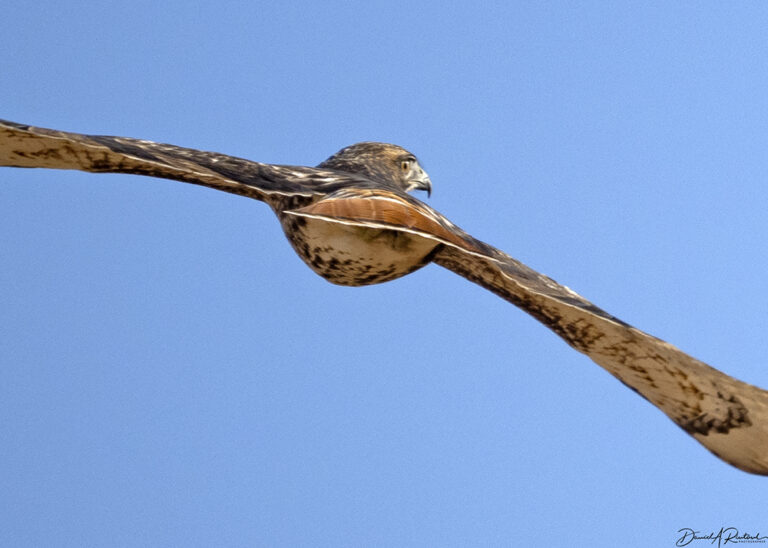
Other winter Red-tailed Hawks are a bit more colorful, but most of them, like this one, prefer to hightail it away from photographers. Click here for larger image.
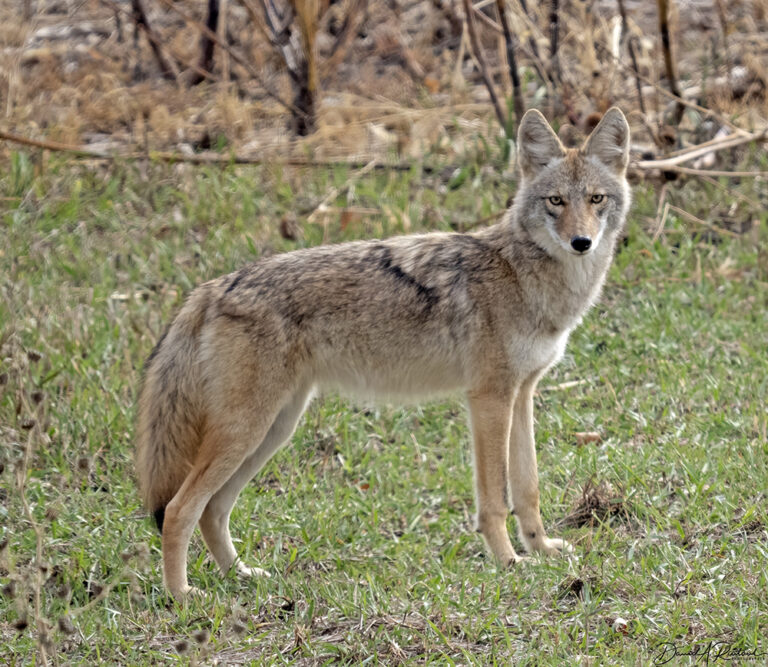
It seems to have been a good summer for our local coyote (Canis latrans) population. This healthy-looking specimen is a good example. Click here for larger image.
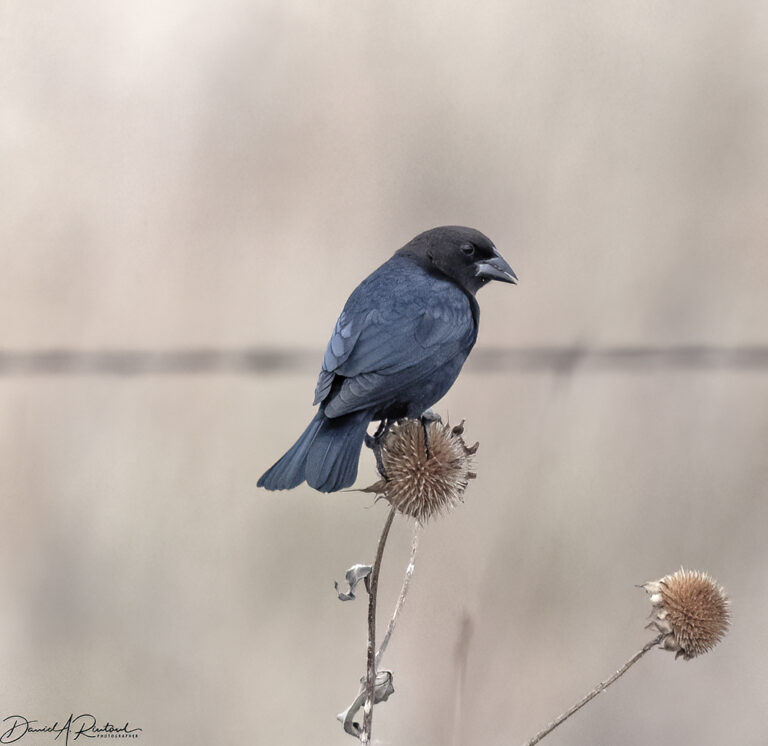
One of the most vilified birds in North America is the Brown-headed Cowbird (Molothrus ater). They have a bad reputation because 1) Humans have expanded their habitat into woodlands and other places where nesting birds are unfamiliar with cowbird habits, and 2) Humans have a strong tendency to project their own value systems onto other species. Thus, laying your eggs in another tiny innocent colorful bird’s nest and hoping that the other bird raises your babies is considered to be awful, immoral, vile, and contemptible by many birders and others. It ain’t so. Cowbirds are doing what they have evolved to do, they are very good at it, and their negative effects on warblers and other colorful birds are entirely due to human alterations of the landscape of this continent. Other reasons to appreciate them: their burbling song has just about the largest frequency range of any avian vocalization, and young male cowbirds have to learn that song after they leave the nest, and thus after the peak song learning window for most birds. Amazing! Click here for larger image.
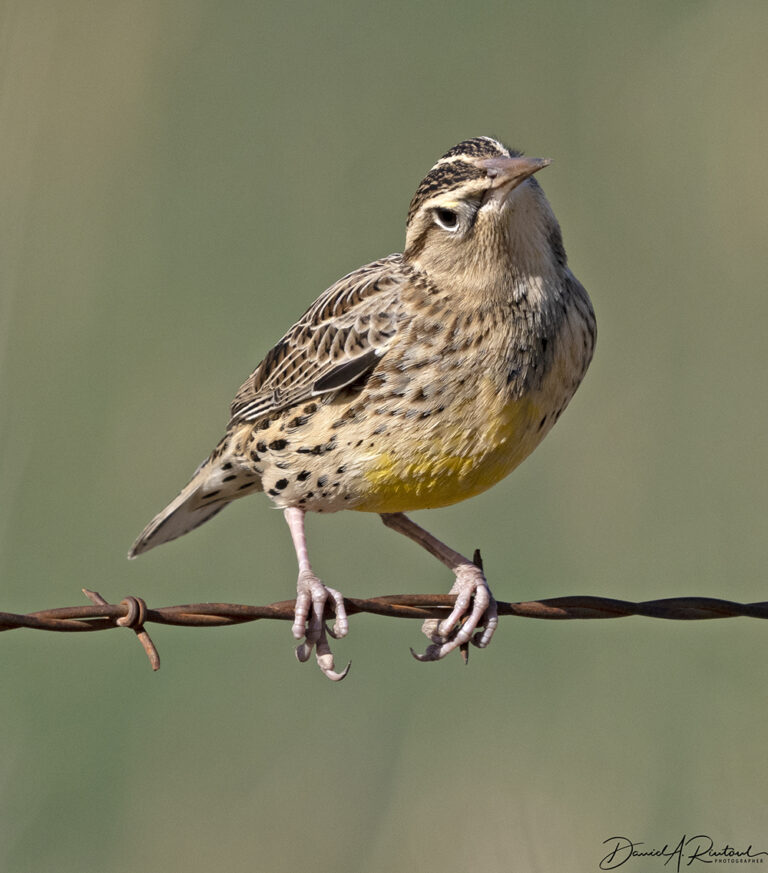
One common cowbird host here in Flyover Country is the Eastern Meadowlark (Sturnella magna). Because they co-evolved with cowbirds, they know how to deal with them and their populations are doing fine. This early winter bird is not very colorful at first glance, but notice that the dark bib and yellow chest are actually visible, just muted. The gray feather tips on those feathers will gradually wear off as time goes by, and by March they will be very colorful, even though they have not undergone a molt. Click here for larger image.
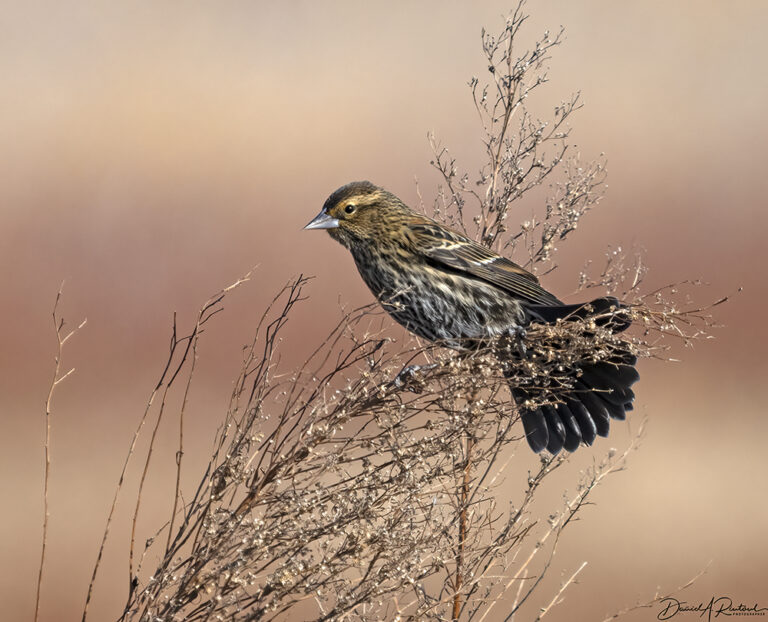
Another common cowbird host is this bird, one of the most abundant species on the continent (if not the planet). You may not recognize it from this picture, and indeed, this species is probably the most misidentified bird on every college ornithology field practical exam. It is a female Red-winged Blackbird (Agelaius phoeniceus). Lots of ornithology students frantically page back and forth in the sparrow section of their field guide (or look at many screens in the sparrow section in their field guide app these days) looking for an ID for this bird and finding nothing close. Click here for larger image.
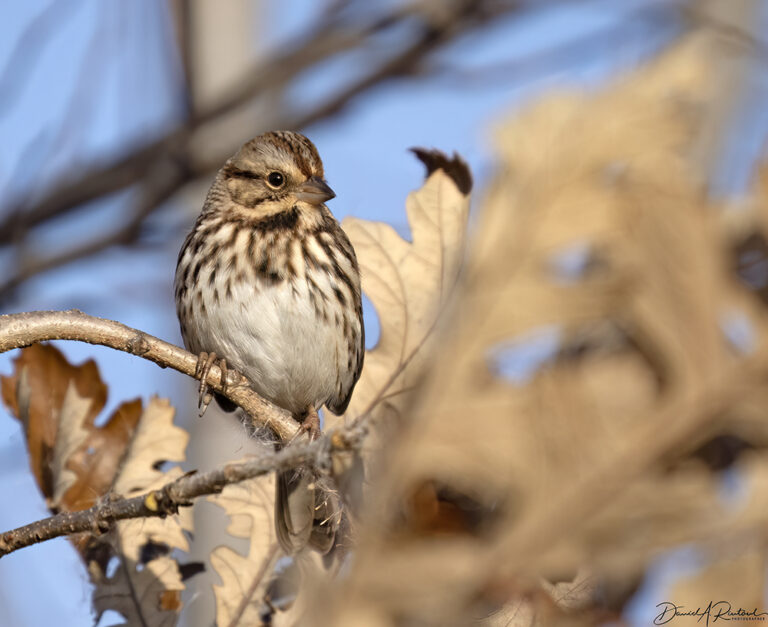
Here is a real sparrow, and another common bird across North America. Song Sparrow (Melospiza melodia) is aptly named, and their cheerful songs are a summertime staple for many North American birders. They do have different dialects, just like those birders; the first time I heard a California Song Sparrow sing, I did not recognize it at all! Click here for larger image.
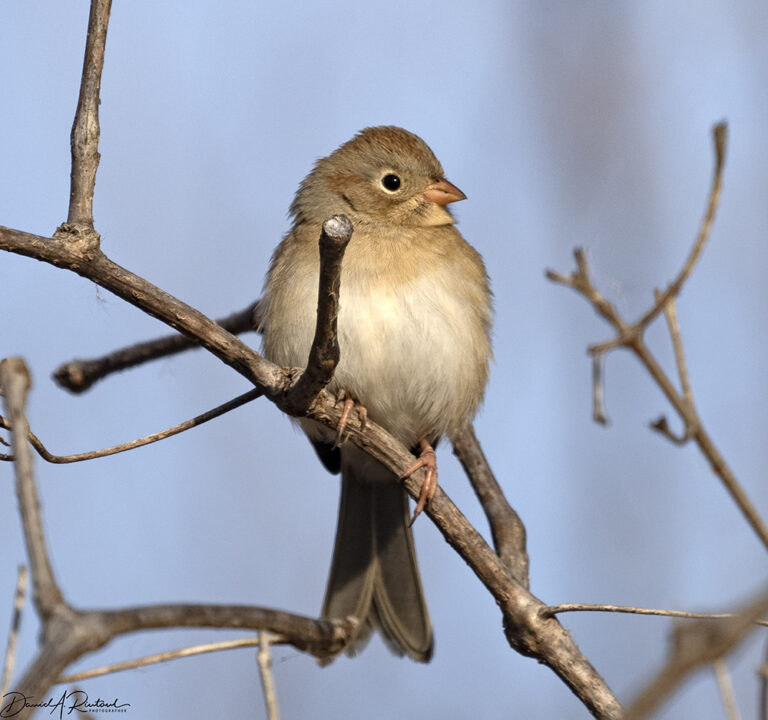
Another subtly handsome sparrow, the Field Sparrow (Spizella pusilla) has an incredibly cheerful “bouncing ball” song, although we won’t hear it often during the winter. Like other birds, these were formerly rare here in the winter, spending their winters further south. But in recent years have come to be an expected species on our Christmas Bird Counts. Click here for larger image.
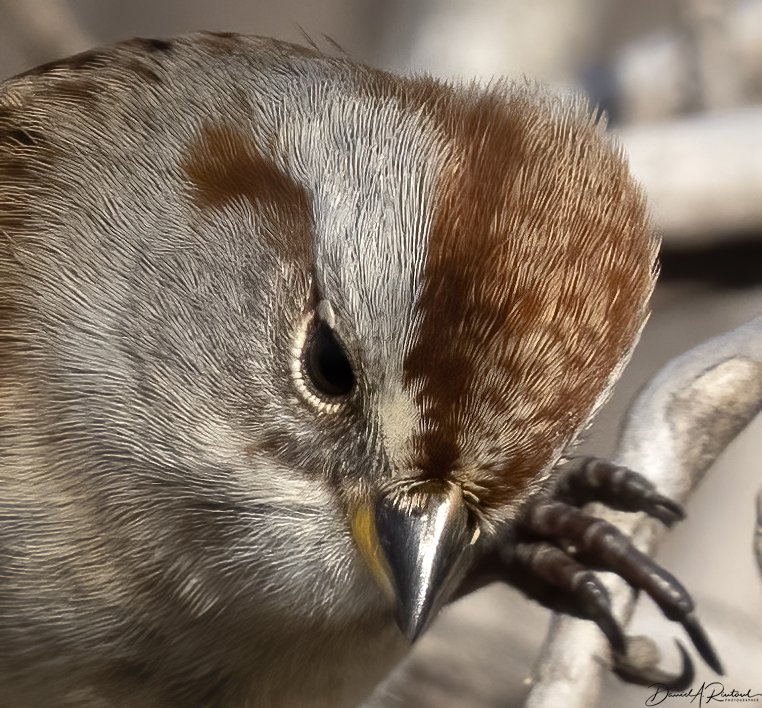
This sparrow, the American Tree Sparrow (Spizelloides arborea) can be super-abundant here in the winter. Birders counted over 31,000 individuals of this species in our CBC circle in 1982, and any outdoor excursion in the winter is guaranteed to scare up dozens of these cuties. Click here for larger image.
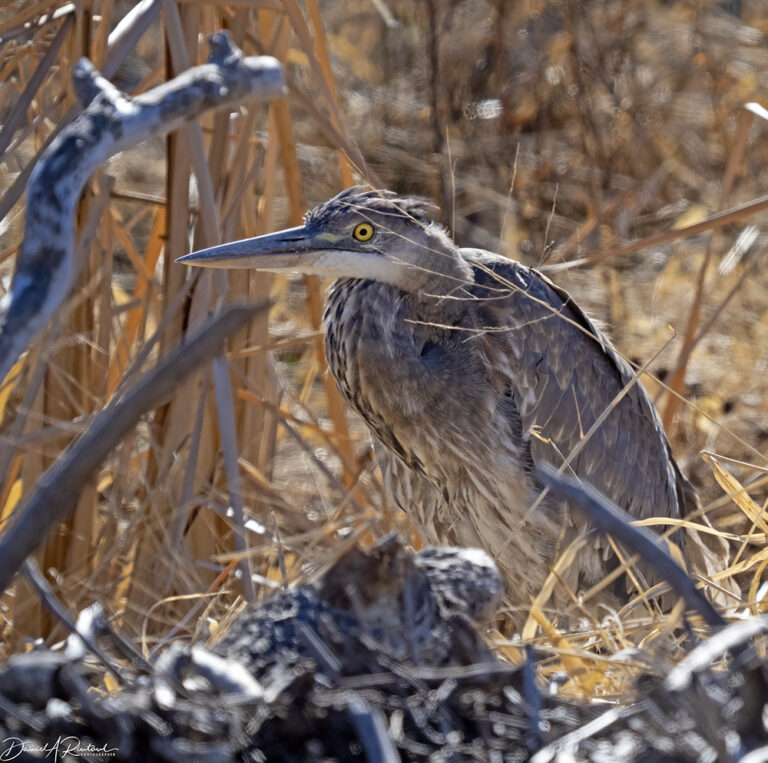
Our final critter is a very grumpy and cold-looking young Great Blue Heron (Ardea herodias), on the morning after our first hard frost. Click here for larger image.

raven
Stunning as usual. I wish I had brought my dslr to the beach. There is an eagle that hangs where I fish but the iPhone camera just won’t cut it!
Pablo
Thanks, lovely pictures and info
Lapassionara
Thanks for an enlightening post.
AM in NC
Just wanted to let you know that your Flyover posts are one think I am thankful for this year. Such amazing photographs, and you always provide great info about the birds. A sincere and warmly sent Thank you!!!!!!!!!!!!!
Albatrossity
@AM in NC: Aww, thanks! I enjoy photographing the birds and sorting through the pictures for these posts, but I’m really glad that others enjoy the outcome as well. And yes, it is a cliché, but I do think giving is as good as or better than receiving. My dopamine rewards are elevated on Monday mornings as well!
OzarkHillbilly
As always, thanx for the ornithology lesson. Got to give a shout out to the female red winged blackbird. her plumage may be just varying shades of grays and browns, but wow, so many different shades. Just beautiful. The details in that tree sparrow shot too. I get lost in those mesmerizing feathers.
J R in WV
Amazing detail on these photos, an OCD person could count the feathers on the American Tree Sparrow’s portrait. And I can read the mind of the Great Blue Heron — he’s thinking “I should be in a Louisiana swamp, not here in Kansas… Bad planning~!!~ Next year!!!”
Thanks so much for sharing these great photos with us, you make Mondays a great start to the week, as we’re retired and don’t have to go to work any more. And the Bird Butts calendar is so funny!!
J R in WV
David,
Can we get a link to acquire your Birb Calendars, please? I don’t see that available on your site! I want some for the birdy neighbors. 3 out of my 4 closest neighbors are bio majors, and everyone loves our local birds.
thanks in advance!
JoyceCB
As a birder myself (but no good as a photographer) in Southern Ontario, I love to try to ID your birds without looking at the caption. We get most of your birds but it is always fun to look at the western birds which we would drive miles to see! I echo the thanks for all your posts.
Albatrossity
@J R in WV: Sure thing, And I’ll add these links to my portfolio site as well.
Birds of Flyover Country 2023
Bird Butts 2023
sab
Will that redtailed hawk be on the 2024 bird butts calendar?
Albatrossity
@sab: Sadly that hawk butt did not make the cut. But if you go to the calendar pages linked above, there is a preview button that should allow you to see what images did rise above the others this year. All images in both calendars are from 2022.
sab
@Albatrossity: 2024 not 2023. I have the 2023 calendar ( it just arrived.) My stepkids were especially impressed with bird butts as a concept.
Albatrossity
@sab: Ah, I did not read that carefully enough. And I have not yet given any thought to 2024! But I’ll keep that in mind. Thanks!
Madeleine
Mr. M and I look forward to your Monday birds and we thank you. The photo of red-tailed hawk #2 is amazing. Took me a moment to figure out what I was seeing.
And thanks for the fine shot of the coyote. Coyotes are becoming common in my Bronx neighborhood (home of many small—leashed—dogs) and I’d like to be able to ID them.
Miss Bianca
Oh, man, Monday Albatrossity posts are da bomb. Love the close-up of the American Tree Sparrow. I had no idea there were so many varieties of sparrow out there!
Chat Noir
Birbs and more birbs! I love your photos and descriptions!
stinger
So glad Harley is back! Thank you for the spirited defense of the cowbird. And everything everybody else said above. The incredible closeups, the depth of field, the encyclopedic knowledge of birds — that one doesn’t molt, just has the color rub off…!!! You are amazing, Albatrossity!
munira
The photo of the female redwing blackbird is stunning and the closeup of the sparrow – wow. Great as always.
JanieM
Thanks as always, Albatrossity, for the gorgeous pictures and fascinating stories.
The paragraph about the cowbird has an odd echo for me in relation to the goings-on at my house one summer involving cliff swallows and house sparrows. Bottom line: I’m pretty sure the house sparrows killed the cliff swallow babies in order to take over the nests. In trying to figure out what was going on, I learned that bluebird lovers in particular are in a perpetual battle against house sparrows, another tale that ultimately involves human alteration of the landscape — in this case the importation of non-native species that native species can’t contend with. (Also involving, perhaps, the love of Shakespeare. But I have a feeling you know that story better than I do.)
C Stars
Beautiful, thank you!
JustRuss
Thanks for sharing about Harley. Saw my first Harlan’s a year or two ago, really enjoy watching them patrol for prey.
mvr
Glad Harley made it back. I actually think that the almost two tone nature of the coloration makes for a super striking pattern that would be hard to match if there were more colors. The double image shows it well. (Other photos are great too, of course!)
Thanks!
StringOnAStick
I always learn so much from your posts, and I revel in their beauty!